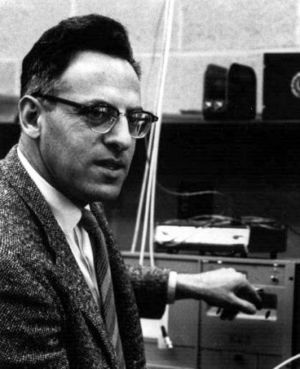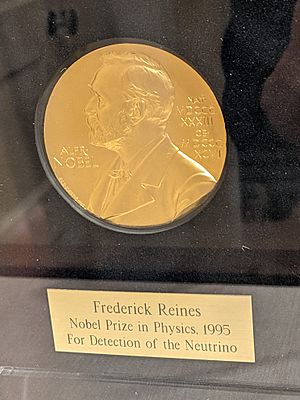Frederick Reines facts for kids
Quick facts for kids
Frederick Reines
|
|
|---|---|
 |
|
| Born | March 16, 1918 |
| Died | August 26, 1998 (aged 80) |
| Citizenship | American |
| Alma mater | New York University Stevens Institute of Technology |
| Known for | Neutrinos |
| Spouse(s) | Sylvia Samuels (m. 1940; 2 children) |
| Awards |
|
| Scientific career | |
| Fields | Physics |
| Institutions |
|
| Thesis | Nuclear fission and the liquid drop model of the nucleus (1944) |
| Doctoral advisor | Richard D. Present |
| Doctoral students | Michael K. Moe (1965) |
Frederick Reines (born March 16, 1918 – died August 26, 1998) was an American physicist. A physicist is a scientist who studies how the universe works. Reines won the Nobel Prize in Physics in 1995. He won it for helping to find the neutrino with Clyde Cowan. The neutrino is a tiny, mysterious particle.
Reines went to Stevens Institute of Technology and New York University. In 1944, he joined the Manhattan Project at Los Alamos Laboratory. This was a secret project during World War II to develop atomic weapons. He worked in the science part of the project. Later, he led a group there. He also took part in several nuclear tests. These were experiments with atomic bombs. In 1951, he directed the Operation Greenhouse tests in the Pacific.
In the early 1950s, Reines and Cowan worked at the Hanford Site and Savannah River Site. They created special equipment. With this, they found neutrinos in June 1956. Before this, many thought neutrinos could not be found. Reines spent most of his career studying neutrinos. His work helped many other scientists. He also found neutrinos made by cosmic rays in the atmosphere. In 1987, he detected neutrinos from Supernova SN1987A. This started a new field called neutrino astronomy.
Contents
Early Life and Education
Frederick Reines was born in Paterson, New Jersey. He was one of four children. His parents were Jewish immigrants from Russia. They met and married in New York City. He had an older sister who became a doctor. He also had two older brothers who became lawyers. Reines said his siblings helped him love learning.
His family moved to Hillburn, New York. His father ran a general store there. Reines spent much of his childhood in this small town. He was an Eagle Scout. He also enjoyed singing. He even thought about becoming a singer. A vocal coach from the Metropolitan Opera gave him free lessons.
Later, his family moved to North Bergen, New Jersey. He went to Union Hill High School. He graduated in 1935. From a young age, Reines loved science. He liked to create and build things. At first, he was better at literature and history. But a teacher helped him improve in science and math. This teacher even gave him a key to the school lab. By his senior year, he loved science. He wrote in his yearbook that he wanted "To be a physicist extraordinaire."
Reines chose to go to Stevens Institute of Technology. He earned his first degree in mechanical engineering in 1939. In 1941, he got a master's degree in mathematical physics. He married Sylvia Samuels in 1940. They had two children, Robert and Alisa. He then went to New York University. He earned his Ph.D. in 1944. His research was about how atoms split.
Working at Los Alamos
In 1944, a famous scientist named Richard Feynman asked Reines to join the Manhattan Project. This was at the Los Alamos Laboratory. Reines stayed there for 15 years. He worked in the part of the lab that focused on theories. In 1946, he became a group leader. He led a team studying a machine called "Dragon." This machine could reach a critical state for short times. It was used for research.
Reines was involved in many nuclear tests. He wrote reports about what happened. These tests included Operation Crossroads and Operation Sandstone. In 1951, he led the Operation Greenhouse tests in the Pacific. These were the first American tests of more powerful atomic bombs. These tests were a step towards making thermonuclear weapons. Reines also studied the effects of nuclear explosions.
Even though he worked on these tests, Reines worried about pollution from them. He became a supporter of testing nuclear weapons underground. He also attended the Atoms for Peace Conference in 1958. This conference aimed to find peaceful uses for atomic energy.
Finding the Neutrino
The neutrino is a tiny particle. It was first suggested by Wolfgang Pauli in 1930. Scientists needed this particle to explain why energy seemed to disappear during a process called beta decay. In beta decay, a neutron changes into a proton and an electron. The neutrino helped keep the law of conservation of energy true.
Enrico Fermi named it the "neutrino," which means "little neutral one" in Italian. In 1934, he said that electrons were made when a neutron changed into a proton, an electron, and a neutrino.
- Template:OptionalLink → Template:OptionalLink + Template:OptionalLink + Template:OptionalLink
The neutrino explained the missing energy. But Fermi's idea was that it had very little mass and no electric charge. This made it seem impossible to see directly. In 1934, two scientists even said there was "no practically possible way of observing the neutrino."
In 1951, Reines and his friend Clyde Cowan decided to try and find neutrinos. Reines later said, "Why did we want to detect the free neutrino? Because everybody said, you couldn't do it."
They knew that a neutrino could combine with a proton. This would create a neutron and a positron.
- Template:OptionalLink + Template:OptionalLink → Template:OptionalLink + Template:OptionalLink
The positron would then meet an electron and make two gamma rays. The neutron would be caught by a proton and release another gamma ray. This would create a special signal they could detect. They added cadmium salt to their liquid detector. This made the neutron capture reaction stronger. It would produce a big burst of gamma rays.
At first, they thought about using an atomic bomb as a neutrino source. But another scientist convinced them to use a nuclear reactor instead. A reactor makes fewer neutrinos than a bomb. But it could run for a long time. This allowed them to do many experiments.
In 1953, they tried their first experiment. They used a reactor at the Hanford Site. Their detector had 300 liters of liquid and 90 special tubes. But noise from cosmic rays made it hard to see the signal. They tried again in 1955. This time, they used a bigger reactor at the Savannah River Site. This reactor made many more neutrinos. They also had a good, protected spot 11 meters from the reactor.
On June 14, 1956, they sent a telegram to Pauli. They announced that the neutrino had been found! When another scientist, Bethe, heard he was wrong, he joked, "Well, you shouldn't believe everything you read in the papers."
Later Research and Discoveries
After finding the neutrino, Reines spent most of his career studying it. His work greatly influenced other scientists. Cowan left Los Alamos in 1957. This ended their work together. Reines became the head of the physics department at Case Western Reserve University in 1959. There, his group was the first to find neutrinos made by cosmic rays in the atmosphere.
Reines had a strong voice and loved to sing. While working as a scientist, he also sang in the Cleveland Orchestra Chorus.
In 1966, Reines moved to the new University of California, Irvine (UCI). He became the first dean of physical sciences there. At UCI, he also helped develop medical radiation detectors. These detectors could measure radiation given to the human body during cancer treatment.
Reines had prepared for a rare event: a supernova explosion. Supernovas are huge star explosions. He hoped to see one in his lifetime. He wanted to catch the neutrinos streaming from it. He even put signs on his detectors, calling them "Supernova Early Warning Systems."
In 1987, neutrinos from Supernova SN1987A were detected. This happened in a detector located in a salt mine. Normally, the detectors saw only a few events each day. But the supernova caused 19 events in just ten seconds! This discovery was very important. It started the field of neutrino astronomy. This is the study of space using neutrinos.
In 1995, Reines won the Nobel Prize in Physics. He shared it with Martin Lewis Perl. He won for his work with Cowan in finding the neutrino. Sadly, Cowan had died in 1974. The Nobel Prize is not given to people after they have passed away.
Reines received many other awards too. These included the National Medal of Science in 1985. He was also elected to the National Academy of Sciences. He retired from being dean at UCI in 1974. He became a professor emeritus in 1988. But he kept teaching until 1991. He stayed at UCI until he died.
Death
Frederick Reines died on August 26, 1998. He passed away after a long illness in Orange, California. His wife and children survived him. His papers are kept at the UCI Libraries. A building at the University of California, Irvine, is named Frederick Reines Hall in his honor. It is where the Physics and Astronomy Department is located.
See also
 In Spanish: Frederick Reines para niños
In Spanish: Frederick Reines para niños






